Research on Promotion and Application Strategy of Electric Equipment in Plateau Railway Tunnel Based on Evolutionary Game
Abstract
1. Introduction
2. Background
- (1)
- Zero exhaust emissions, low noise, effectively improve the tunnel working environment. Compared with fuel-based equipment, electric equipment achieves zero tailpipe emissions [47]. In addition, the motor drive considerably reduces the noise in the working environment compared to the fuel equipment, and the improvement on the tunnel working environment is evident.
- (2)
- It solves the problem of oxygen competition between fuel equipment and people, and relieves the pressure on the ventilation system. The oxygen content of the tunnel environment in the plateau is thin, so it is necessary to enhance ventilation and timely oxygen generation to replenish the oxygen content of the tunnel environment. In contrast to fuel equipment, electric equipment does not require oxygen-consuming combustion and does not consume oxygen in the tunnel, which solves the problem of oxygen competition between fuel equipment and people, and relieves the pressure of ventilation and oxygen production in the plateau tunnel [48,49].
- (3)
- In the plateau environment, electric equipment ensures working efficiency. The efficiency of fuel oil equipment decreases as the oxygen content decreases due to altitude hypoxia [4]. Electric equipment effectively avoids this situation and ensures the operational efficiency of mechanical equipment.
- (4)
- Electrical equipment has a long maintenance cycle and low maintenance costs, which reduce the cost of use. Engine systems of fuel equipment require regular replacement and maintenance of oil, oil filters, air filters, and fuel filters. As the altitude increases and the dust content and air humidity increase in the working environment, the frequency of maintenance of fuel equipment needs to increase and the cost of maintenance increases accordingly [50]. The maintenance of the frequency motor system of electric equipment is greatly reduced and the cost of maintenance is considerably reduced.
- (5)
- The energy cost of electric equipment is much lower than that of oil equipment. Based on a crude calculation of fuel prices and electricity prices, the energy consumption cost of electric equipment is about half that of fuel equipment [51].
3. Methods
3.1. Problem Description and Basic Assumptions
3.2. Evolutionary Game Model
3.3. Replicator Dynamic Analysis
3.3.1. Government
- (1)
- When , then for any x ∈ [0, 1], F(x) = 0, , the x-axis is in a stable state, and any strategies of the government are stable.
- (2)
- When , , , we can see that x = 1 is the only ESS. At this time, the government chooses Positive regulation is the optimal strategy.
- (3)
- When , , , we can see that x = 0 is the only ESS. At this time, the government chooses Negative regulation is the optimal strategy.
3.3.2. Equipment Manufacturers
- (1)
- When , then for any y ∈ [0, 1], F(y) = 0, , the y-axis is in a stable state, and any strategies of the equipment manufacturers are stable.
- (2)
- When , , , we can see that y = 0 is the only ESS. At this time, the equipment manufacturers choose negative innovation is the optimal strategy.
- (3)
- When , ,, we can see that y = 1 is the only ESS. At this time, the equipment manufacturers choose positive innovation is the optimal strategy.
3.3.3. Construction Units
- (1)
- When , then for any z ∈ [0, 1], F(z) = 0, , the z-axis is in a stable state, and any strategies of the equipment manufacturers are stable.
- (2)
- When , , we can see that z = 0 is the only ESS. At this time, the construction units choose negative application is the optimal strategy.
- (3)
- When , , we can see that z = 1 is the only ESS. At this time, the construction units choose positive application is the optimal strategy.
3.4. Tripartite Game Equilibrium Solution
4. Numerical Example
4.1. Case Description and Parameter Settings
4.2. The Impact of Selecting an Initial Change of Strategy on Evolutionary Results
4.2.1. Government
4.2.2. Equipment Manufacturers
4.2.3. Construction Units
4.3. The Impact of Selecting a Parameter Change of Strategy on Evolutionary Results
- When the government departments regulate the implementation of environmental pollution of construction units to impose fines, construction units tend to positively apply (see Figure 9).
- When the incentives of government departments for manufacturers to carry out electric equipment technology innovation increase, equipment manufacturers tend to positively innovate (see Figure 10).
- When the construction units get more subsidies from government departments through the deployment and application of electric equipment, the construction unit tends to positively apply it (see Figure 11).

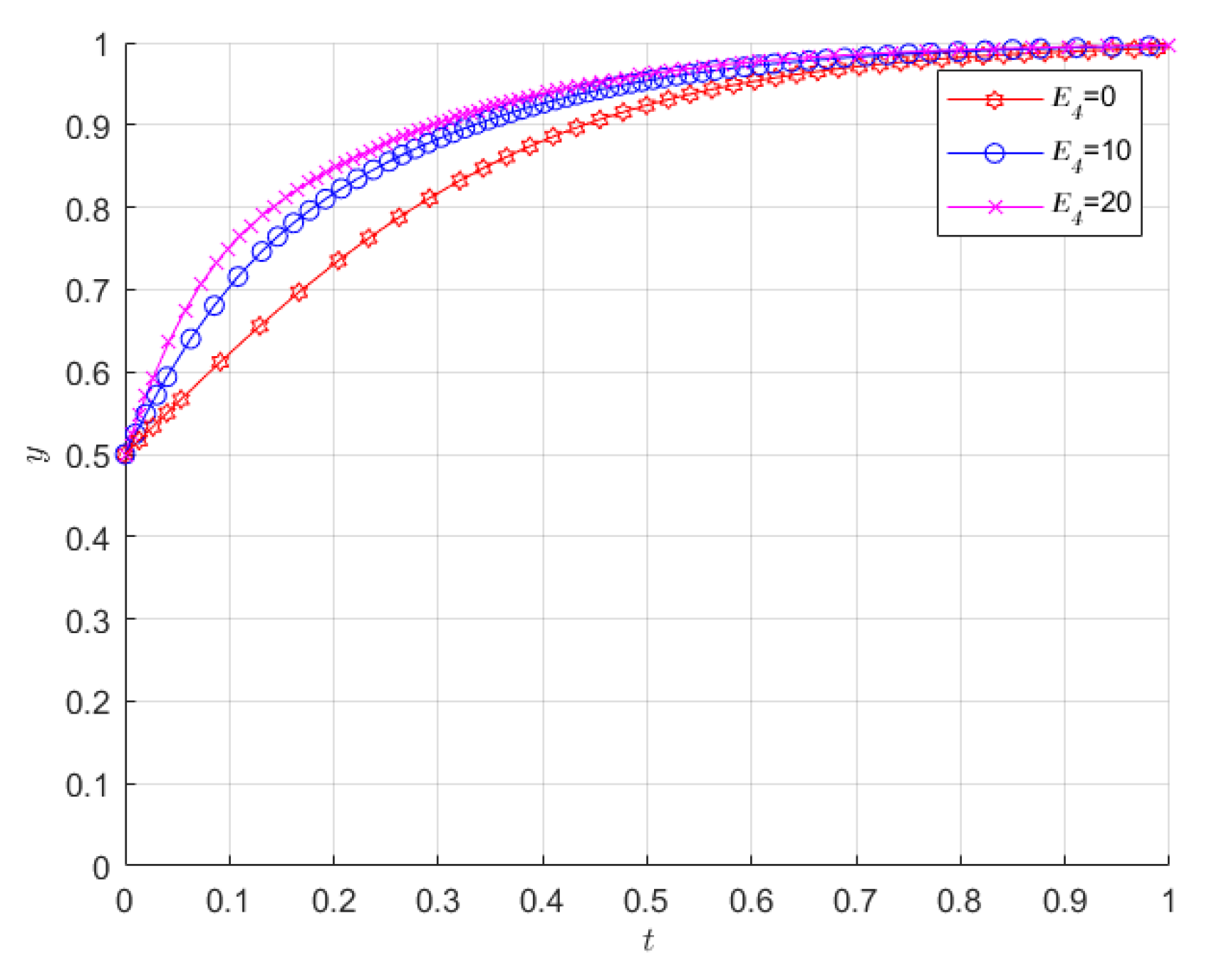
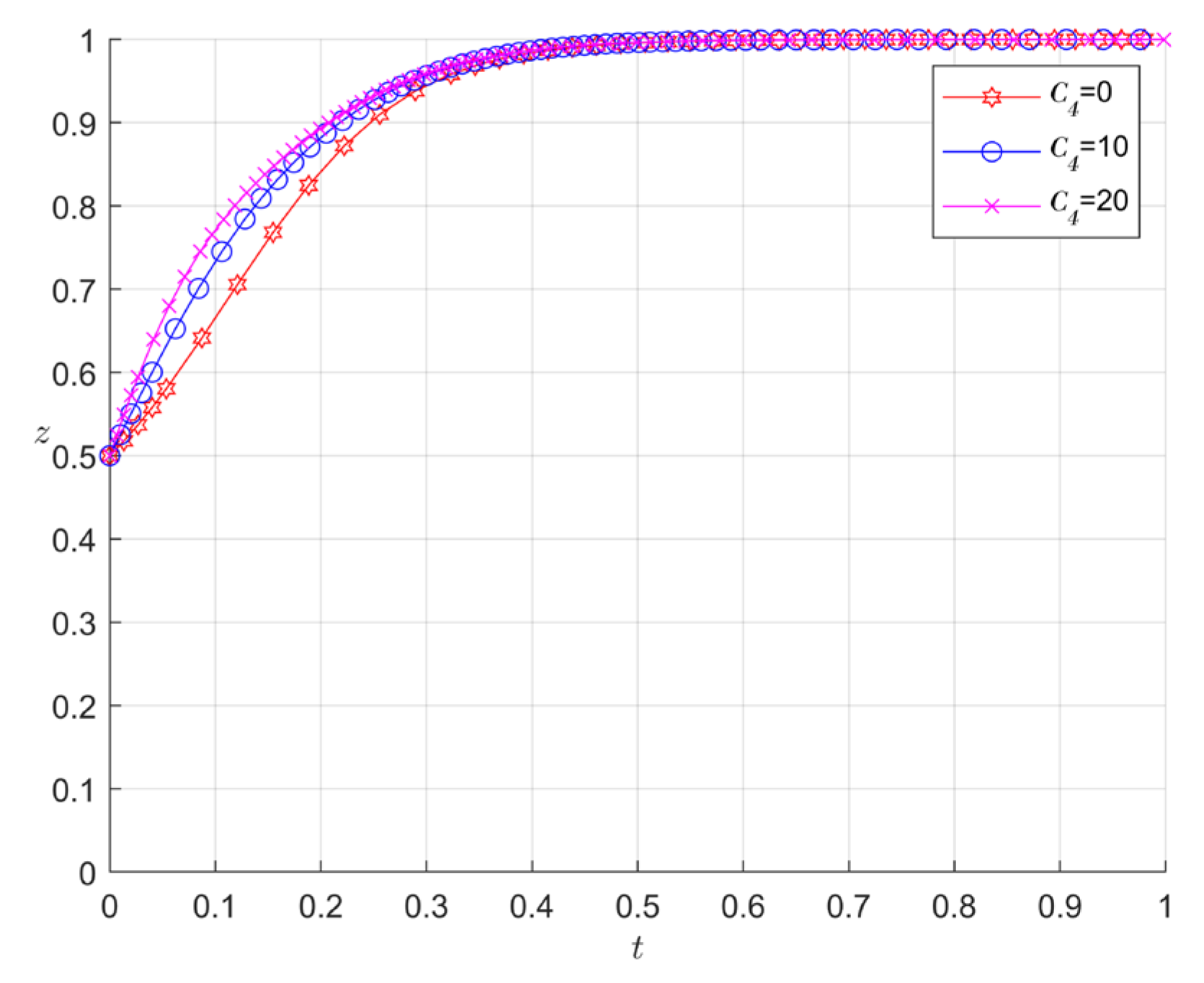
5. Results and Discussion
- (1)
- In the early stage of the development of the new energy industry, the government should actively carry out regulation and encourage equipment manufacturers to innovate and upgrade the electric equipment. Based on the strengthened certification of electric equipment specifications, preferential policies such as accelerated depreciation, value-added tax, and income tax reduction should be given to electric equipment manufacturers to reduce risks for equipment manufacturers in the early stages of research and development. At the same time, the government should adopt mandatory and encouraging policies for construction units: improve market acceptance and application demonstration of electric equipment through the promulgation of preferential policies such as tax reduction and exemption. By imposing a plateau pollution tax, the cost of plateau applications of conventional fuel oil equipment is increased, resulting in a relative reduction in expenditure on electric equipment. The government may take incentives such as bid requirements and contract performance to require and encourage the participating construction units to purchase a certain proportion of electric equipment in the first line, thereby promoting the promotion and application of electric equipment. In the long-term context, to achieve the goal of promoting and applying electric equipment in railway tunnels on the plateau, government departments must be market-oriented, play a leading role in market mechanisms, and encourage innovative production to drive the industry.
- (2)
- The innovation enthusiasm of equipment manufacturers is affected by their innovation cost. In the early stage of industrial development, the high cost of innovation will affect the innovation decisions of equipment manufacturers, and the government should give a certain level of support. Equipment manufacturers should actively respond to calls from government departments to formulate a strategy for electric equipment development, strengthen research and development of core technologies for electric equipment, and actively carry out technological updates and iterations to enhance market competitiveness. At the same time, the equipment manufacturer should take the initiative to contact line construction units, understanding plateau tunnel construction specifically needs a line of electric equipment, actively carry out live trial, plateau tunnel around the overall cost and battery life, the size of the equipment, plateau, such as the stability and safety charging pile in actual combat vehicle technology research and development and the core components technical research.
- (3)
- Construction units should actively respond to the call of government departments, take the initiative to deploy electric equipment in the tunnel construction line, take the lead in demonstration and application, improve the working environment of plateau tunnels, and gradually ban traditional fuel oil equipment with the trend of industrial upgrading. At the same time, the construction unit shall be equipped with auxiliary plant trial and error, technological innovation for plateau railway tunnel space is relatively closed, low pressure, low oxygen, dust, damp environment, and the possibility of high geothermal, water inrush and gas outburst, rock burst mud such as geological environment, actively summarize feedback early application of electric equipment, application problem, and the key technical problems in the pilot demonstration area, accelerating industrial upgrading.
Author Contributions
Funding
Institutional Review Board Statement
Informed Consent Statement
Data Availability Statement
Conflicts of Interest
References
- Moore, G. Surface pressure record of Tibetan Plateau warming since the 1870s. Q. J. R. Meteor. Soc. 2012, 138, 1999–2008. [Google Scholar] [CrossRef]
- Du, H.; Xue, X.; Wang, T.; Lu, S.; Liao, J.; Li, S.; Fan, Y.; Liu, X. Modeling dust emission in alpine regions with low air temperature and low air pressure—A case study on the Qinghai-Tibetan Plateau (QTP). Geoderma 2022, 422, 115930. [Google Scholar] [CrossRef]
- Saha, K.; Vandendool, H.; Saha, S. On the annual cycle in surface pressure on the tibetan plateau compared to its surroundings. J. Clim. 1994, 7, 2014–2019. [Google Scholar] [CrossRef]
- Guo, D.; Li, G.; Hu, N.; Hou, J. System Dynamics Analysis of Man-Machine Efficacy in Plateau Mines. IEEE Access 2021, 9, 18072–18084. [Google Scholar] [CrossRef]
- Attfield, M.D.; Schleiff, P.L.; Lubin, J.H.; Blair, A.; Stewart, P.A.; Vermeulen, R.; Coble, J.B.; Silverman, D.T. The Diesel Exhaust in Miners Study: A Cohort Mortality Study with Emphasis on Lung Cancer. J. Natl. Cancer Inst. 2012, 104, 869–883. [Google Scholar] [CrossRef]
- Li, C.; Jiang, Z.; Zhang, G.; Feng, X.; Zeng, F. Dust pollution during shotcrete process in high-altitude tunnel based on numerical simulation. Particuology 2022, 75, 82–95. [Google Scholar] [CrossRef]
- Wang, J.; Kong, X.; Fan, Y.; Jiang, X.; Lu, K. Reduced pressure effects on smoke temperature, CO concentration and smoke extraction in tunnel fires with longitudinal ventilation and vertical shaft. Case Stud. Therm. Eng. 2022, 37, 102311. [Google Scholar] [CrossRef]
- Feng, X.; Jiang, Z.; Zhang, G.; Luo, X.; Zeng, F. Study on CO diffusion law and concentration distribution function under ventilation after blasting in high-altitude tunnel. J. Wind Eng. Ind. Aerodyn. 2022, 220, 104871. [Google Scholar] [CrossRef]
- Su, Y.; Liu, M.; De Silva, P.V.; Østbye, T.; Jin, K. Health-related quality of life in Chinese workers: A systematic review and meta-analysis. Glob. Health Res. Pol. 2021, 6, 29. [Google Scholar] [CrossRef]
- Wu, P.; Yang, F.; Zheng, J.; Wei, Y. Evaluating the Highway Tunnel Construction in Western Sichuan Plateau Considering Vocational Health and Environment. Int. J. Environ. Res. Public Health 2019, 16, 4671. [Google Scholar] [CrossRef]
- Zhang, P.; Hu, J.; Zhao, K.; Chen, H.; Zhao, S.; Li, W. Dynamics and Decoupling Analysis of Carbon Emissions from Construction Industry in China. Buildings 2022, 12, 257. [Google Scholar] [CrossRef]
- Dong, Z.L.; Wang, B.S.; Li, J. Effects of Petroleum Hydrocarbon Contamination on Soil Bacterial Diversity in the Permafrost Region of the Qinghai-Tibetan Plateau. Soil Sediment Contam. Int. J. 2020, 29, 322–339. [Google Scholar] [CrossRef]
- Zhang, M.; Pei, W.; Zhang, X.; Lu, J. Lateral thermal disturbance of embankments in the permafrost regions of the Qinghai-Tibet Engineering Corridor. Nat. Hazards 2015, 78, 2121–2142. [Google Scholar] [CrossRef]
- Wang, G.; Yan, X.; Zhang, F.; Zeng, C.; Gao, D. Traffic-Related Trace Element Accumulation in Roadside Soils and Wild Grasses in the Qinghai-Tibet Plateau, China. Int. J. Environ. Res. Public Health 2014, 11, 456–472. [Google Scholar] [CrossRef]
- Foroutan, F.; Mousavi Gazafrudi, S.M.; Shokri-Ghaleh, H. A Comparative Study of Recent Optimization Methods for Optimal Sizing of a Green Hybrid Traction Power Supply Substation. Arch. Comput. Method E 2021, 28, 2351–2370. [Google Scholar] [CrossRef]
- Xiang, Z.M.; Yuan, R.A. Mechanical Equipment Coordination and Operation Mode of Wuhan-Guangzhou Passenger Dedicated Line Large Cross-Section Tunnel Construction. Adv. Mater. Res. 2011, 393–395, 166–169. [Google Scholar] [CrossRef]
- Wang, F.; Zhou, K.; Zhou, L. Study on Adaptability of Mechanized Matching Construction of Sichuan-Tibet Railway Tunnel. Mod. Tunn. Technol. 2020, 57, 57–62. (In Chinese) [Google Scholar]
- Zhang, H.; Sun, J.; Ma, H.; Chen, S.; Huang, M. Development and Application of Mechanized Matching Equipment for High-Speed Railway Tunnel Construction. Procedia Manuf. 2019, 32, 952–959. [Google Scholar] [CrossRef]
- Song, Z.; Xia, Z. Carbon Emission Reduction of Tunnel Construction Machinery System Based on Self-Organizing Map-Global Particle Swarm Optimization with Multiple Weight Varying Models. IEEE Access 2022, 10, 50195–50217. [Google Scholar] [CrossRef]
- Xing, B.; Feng, H. Suggestions and considerations on equipment selection for constructing Sichuan-Tibet railway tunnels at high altitudes. Tunn. Constr. 2021, 41, 1644–1653. (In Chinese) [Google Scholar]
- Wang, Z.; Han, Y.; Xing, P. Study on application of electric new energy equipment in new railway tunnel construction in plateau mountainous area. Railw. Eng. Technol. Econ. 2022, 37, 10–13. (In Chinese) [Google Scholar]
- Axsen, J.; Kurani, K.S. Early U.S. Market for Plug-In Hybrid Electric Vehicles. Transp. Res. Rec. J. Transp. Res. Board 2009, 2139, 64–72. [Google Scholar] [CrossRef]
- Wang, Z.; Wang, C.; Hao, Y. Influencing factors of private purchasing intentions of new energy vehicles in China. J. Renew. Sustain. Energy 2013, 5, 63133. [Google Scholar] [CrossRef]
- Hirte, G.; Tscharaktschiew, S. The optimal subsidy on electric vehicles in German metropolitan areas: A spatial general equilibrium analysis. Energy Econ. 2013, 40, 515–528. [Google Scholar] [CrossRef]
- Xie, Y.; Wu, D.; Zhu, S. Can new energy vehicles subsidy curb the urban air pollution? Empirical evidence from pilot cities in China. Sci. Total Environ. 2021, 754, 142232. [Google Scholar] [CrossRef]
- Hoen, A.; Koetse, M.J. A choice experiment on alternative fuel vehicle preferences of private car owners in the Netherlands. Transp. Res. Part A Policy Pract. 2014, 61, 199–215. [Google Scholar] [CrossRef]
- Erdem, C.; Şentürk, İ.; Şimşek, T. Identifying the factors affecting the willingness to pay for fuel-efficient vehicles in Turkey: A case of hybrids. Energy Policy 2010, 38, 3038–3043. [Google Scholar] [CrossRef]
- Carley, S.; Krause, R.M.; Lane, B.W.; Graham, J.D. Intent to purchase a plug-in electric vehicle: A survey of early impressions in large US cites. Transp. Res. Part D Transport. Environ. 2013, 18, 39–45. [Google Scholar] [CrossRef]
- Li, J.; Zhou, Y.; Yu, D.; Liu, C. Consumers’ Purchase Intention of New Energy Vehicles: Do Product-Life-Cycle Policy Portfolios Matter? Sustainability 2020, 12, 1711. [Google Scholar] [CrossRef]
- Rahbari, O.; Vafaeipour, M.; Omar, N.; Rosen, M.A.; Hegazy, O.; Timmermans, J.; Heibati, S.; Bossche, P.V.D. An optimal versatile control approach for plug-in electric vehicles to integrate renewable energy sources and smart grids. Energy 2017, 134, 1053–1067. [Google Scholar] [CrossRef]
- Egbue, O.; Long, S. Barriers to widespread adoption of electric vehicles: An analysis of consumer attitudes and perceptions. Energy Policy 2012, 48, 717–729. [Google Scholar] [CrossRef]
- Sun, H.; Wan, Y.; Lv, H. System Dynamics Model for the Evolutionary Behaviour of Government Enterprises and Consumers in China’s New Energy Vehicle Market. Sustainability 2020, 12, 1578. [Google Scholar] [CrossRef]
- Jiang, C.; Zhang, Y.; Bu, M.; Liu, W. The Effectiveness of Government Subsidies on Manufacturing Innovation: Evidence from the New Energy Vehicle Industry in China. Sustainability 2018, 10, 1692. [Google Scholar] [CrossRef]
- Lee, E.Y.; Cin, B.C. The effect of risk-sharing government subsidy on corporate R&D investment: Empirical evidence from Korea. Technol. Forecast. Soc. 2010, 77, 881–890. [Google Scholar]
- Li, J.; Jiao, J.; Tang, Y. An evolutionary analysis on the effect of government policies on electric vehicle diffusion in complex network. Energy Policy 2019, 129, 1–12. [Google Scholar] [CrossRef]
- Yu, F.; Wang, L.; Li, X. The effects of government subsidies on new energy vehicle enterprises: The moderating role of intelligent transformation. Energy Policy 2020, 141, 111463. [Google Scholar] [CrossRef]
- Ozaki, R.; Sevastyanova, K. Going hybrid: An analysis of consumer purchase motivations. Energy Policy 2011, 39, 2217–2227. [Google Scholar] [CrossRef]
- Earl, J.; Fell, M.J. Electric vehicle manufacturers’ perceptions of the market potential for demand-side flexibility using electric vehicles in the United Kingdom. Energy Policy 2019, 129, 646–652. [Google Scholar] [CrossRef]
- Gallagher, K.S.; Muehlegger, E. Giving green to get green? Incentives and consumer adoption of hybrid vehicle technology. J. Environ. Econ. Manag. 2011, 61, 1–15. [Google Scholar] [CrossRef]
- Zhao, D.; Ji, S.; Wang, H.; Jiang, L. How do government subsidies promote new energy vehicle diffusion in the complex network context? A three-stage evolutionary game model. Energy 2021, 230, 120899. [Google Scholar] [CrossRef]
- Jiang, K.; You, D.; Merrill, R.; Li, Z. Implementation of a multi-agent environmental regulation strategy under Chinese fiscal decentralization: An evolutionary game theoretical approach. J. Clean Prod. 2019, 214, 902–915. [Google Scholar] [CrossRef]
- Liu, K.; Liu, Y.; Zhou, H.; Kou, Y.; Ji, Q.; Li, D. Evolutionary game and numerical simulation of participants’ collaborative behavior in integrated project delivery project. Alex Eng. J. 2021, 60, 373–385. [Google Scholar] [CrossRef]
- Hou, J.; Li, B. The Evolutionary Game for Collaborative Innovation of the IoT Industry under Government Leadership in China: An IoT Infrastructure Perspective. Sustainability 2020, 12, 3648. [Google Scholar] [CrossRef]
- Fang, Y.; Wei, W.; Liu, F.; Mei, S.; Chen, L.; Li, J. Improving solar power usage with electric vehicles: Analyzing a public-private partnership cooperation scheme based on evolutionary game theory. J. Clean Prod. 2019, 233, 1284–1297. [Google Scholar] [CrossRef]
- Wang, J.; Hu, Y.; Qu, W.; Ma, L. Research on Emergency Supply Chain Collaboration Based on Tripartite Evolutionary Game. Sustainability 2022, 14, 11893. [Google Scholar] [CrossRef]
- Li, D.; Wang, Y. Online Learning Management for Primary and Secondary Students during the COVID-19 Epidemic: An Evolutionary Game Theory Approach. Sustainability 2022, 14, 12416. [Google Scholar] [CrossRef]
- Karaoglan, M.U. Drive cycle performance analysis for various powertrain alternatives of zero-emission battery electric military vehicles. Int. J. Global Warm. 2021, 25, 482–497. [Google Scholar] [CrossRef]
- Sanxiang, S.; Yunxia, Z. in Monitoring of Harmful Gas for Yangbajing 1# Tunnel in High Altitude Plateau. In Proceedings of the 2014 Sixth International Conference on Measuring Technology and Mechatronics Automation, Zhangjiajie, China, 10–11 January 2014; pp. 410–412. [Google Scholar]
- Wu, B.; Zhao, R.; Meng, G.; Xu, S.; Qiu, W.; Chen, H. A numerical study on CO migration after blasting in high-altitude tunnel by inclined shaft. Sci. Rep. 2022, 12, 14696. [Google Scholar] [CrossRef] [PubMed]
- Woś, P.; Michalski, J. Effect of Initial Cylinder Liner Honing Surface Roughness on Aircraft Piston Engine Performances. Tribol. Lett. 2011, 41, 555–567. [Google Scholar] [CrossRef]
- Anselma, P.G.; Belingardi, G. Fuel cell electrified propulsion systems for long-haul heavy-duty trucks: Present and future cost-oriented sizing. Appl. Energy 2022, 321, 119354. [Google Scholar] [CrossRef]
- Lu, C.; Liu, J.; Liu, Y.; Liu, Y. Intelligent construction technology of railway engineering in China. Front. Eng. Manag. 2019, 6, 503–516. [Google Scholar] [CrossRef]
- Lu, C.; Cai, C. Challenges and Countermeasures for Construction Safety during the Sichuan–Tibet Railway Project. Engineering 2019, 5, 833–838. [Google Scholar] [CrossRef]
- Qiu, Y.; Chen, H.; Sheng, Z.; Cheng, S. Governance of institutional complexity in megaproject organizations. Int. J. Proj. Manag. 2019, 37, 425–443. [Google Scholar] [CrossRef]
- Zhang, D.; Sun, Z.; Fang, Q. Scientific problems and research proposals for Sichuan–Tibet railway tunnel construction. Undergr. Space 2021, 7, 419–439. [Google Scholar] [CrossRef]
- Wang, S.; Zhao, F.; Liu, Z.; Hao, H. Heuristic method for automakers’ technological strategy making towards fuel economy regulations based on genetic algorithm: A China’s case under corporate average fuel consumption regulation. Appl. Energy 2017, 204, 544–559. [Google Scholar] [CrossRef]
- Zhao, T.; Liu, Z. A novel analysis of carbon capture and storage (CCS) technology adoption: An evolutionary game model between stakeholders. Energy 2019, 189, 116352. [Google Scholar] [CrossRef]
- Liu, K.; Zhou, H.; Kou, Y.; Zhang, J.; Zhou, X.; Zhang, X. Simulation study on passive buildings’ demand incentive based on evolutionary game. J. Intell. Fuzzy Syst. 2019, 37, 3163–3174. [Google Scholar] [CrossRef]
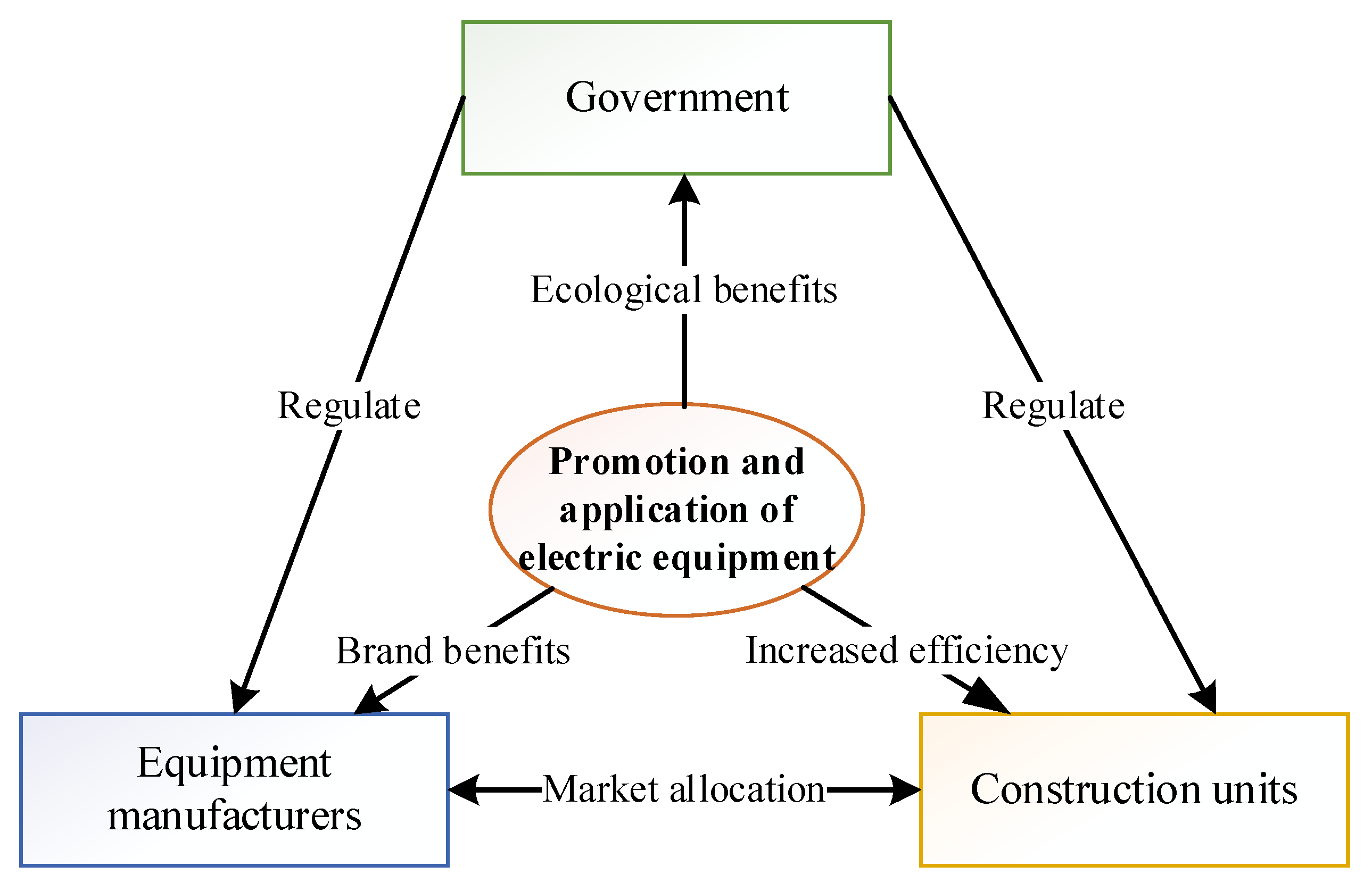
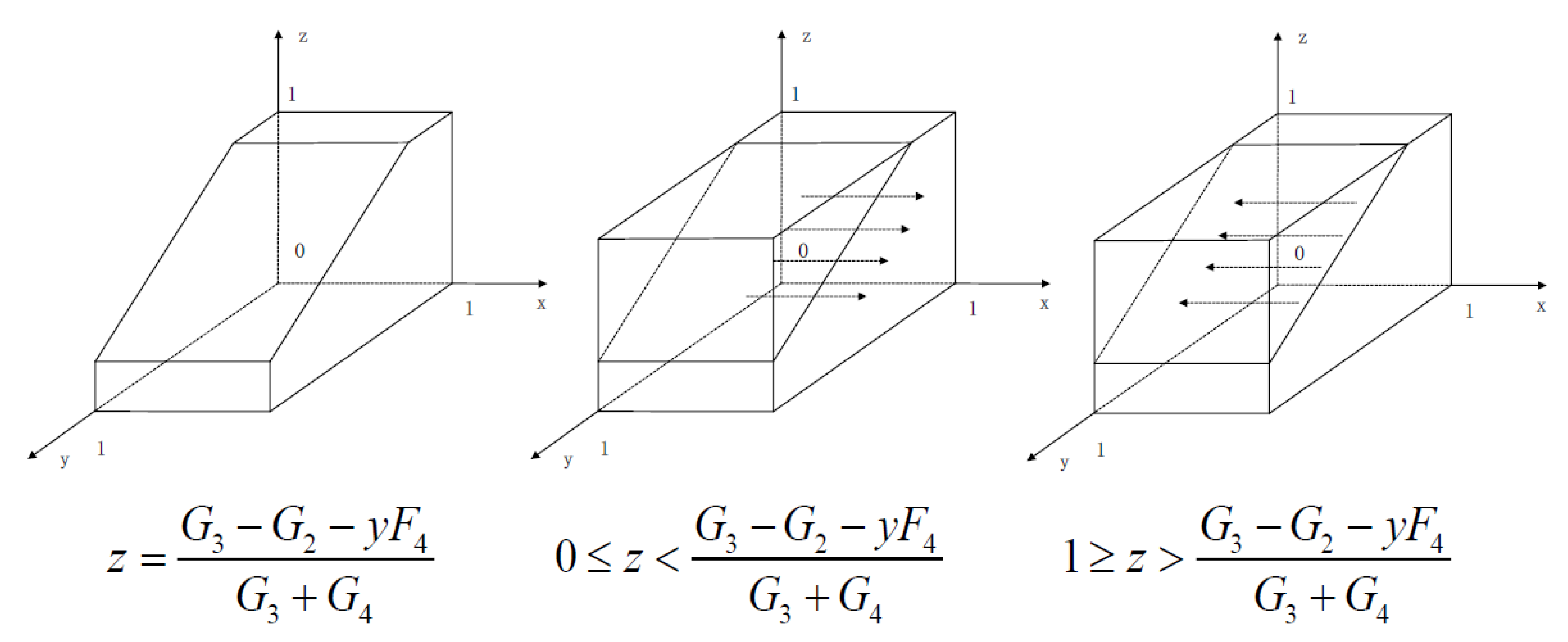
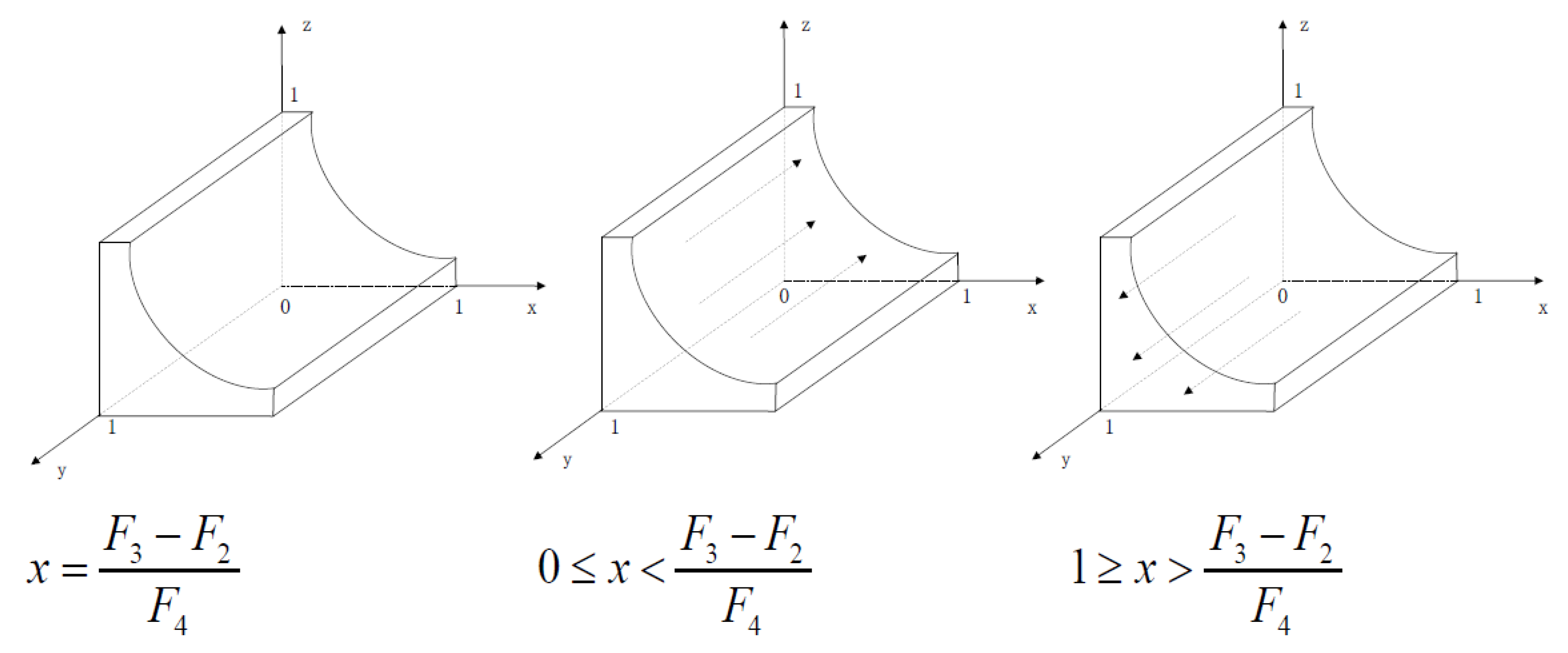
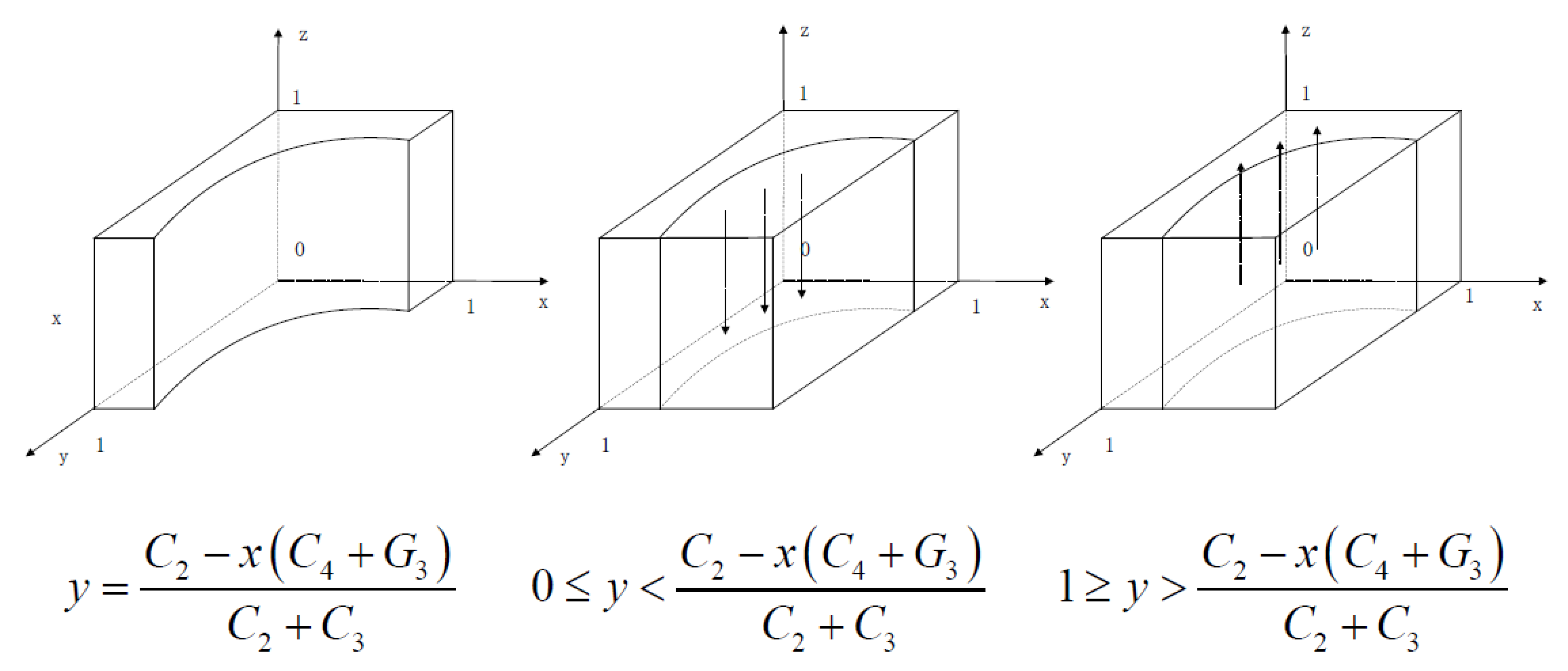
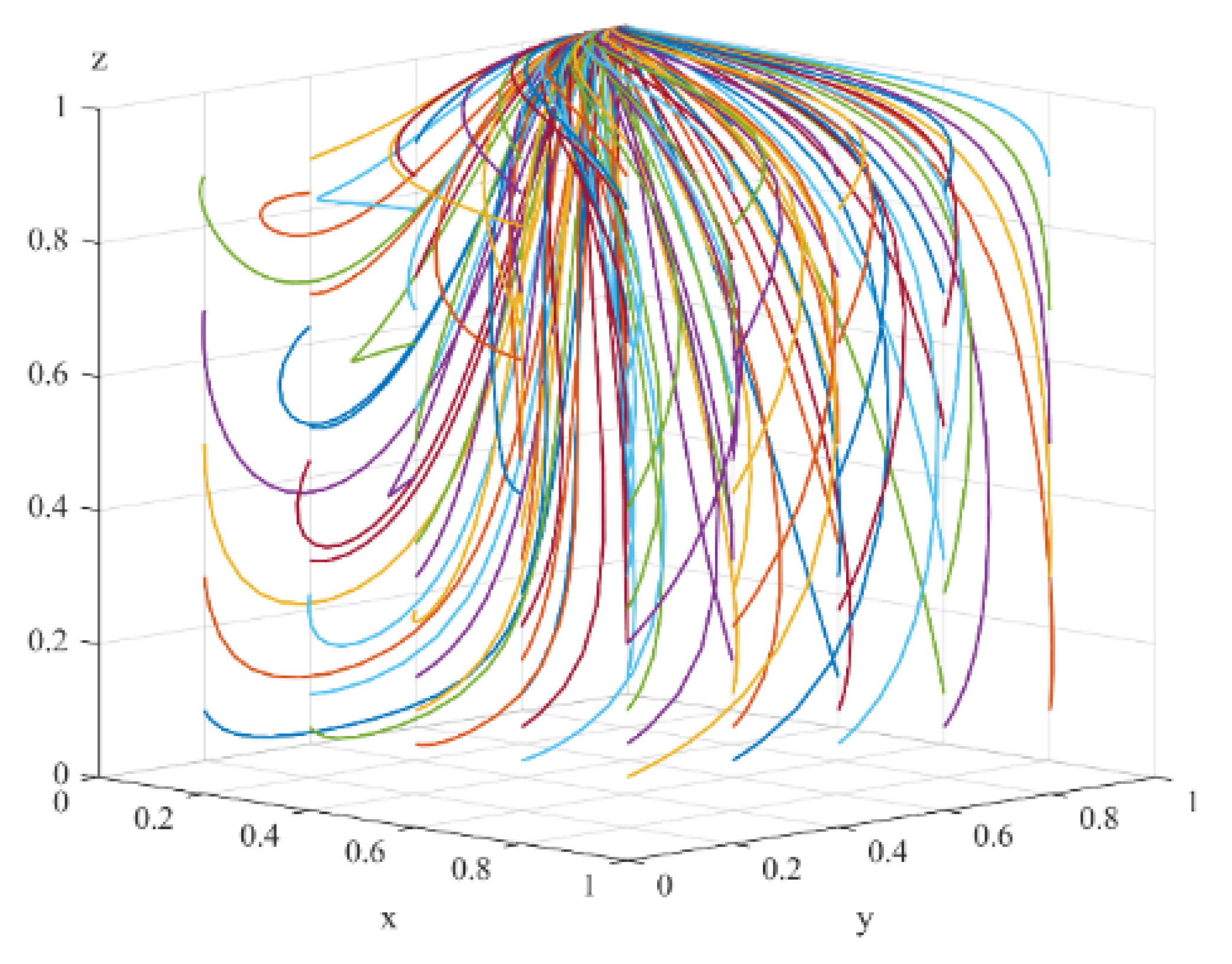




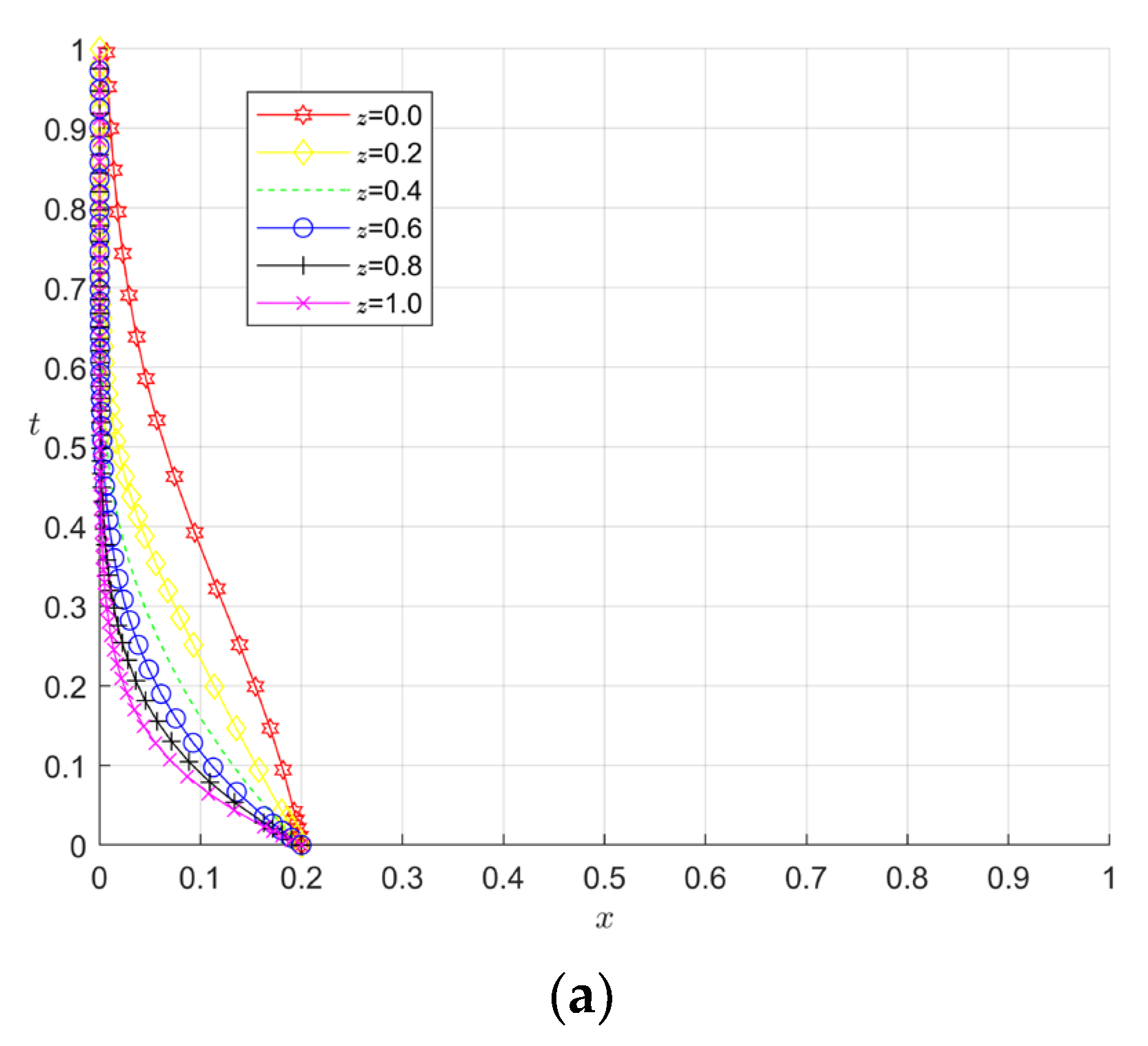

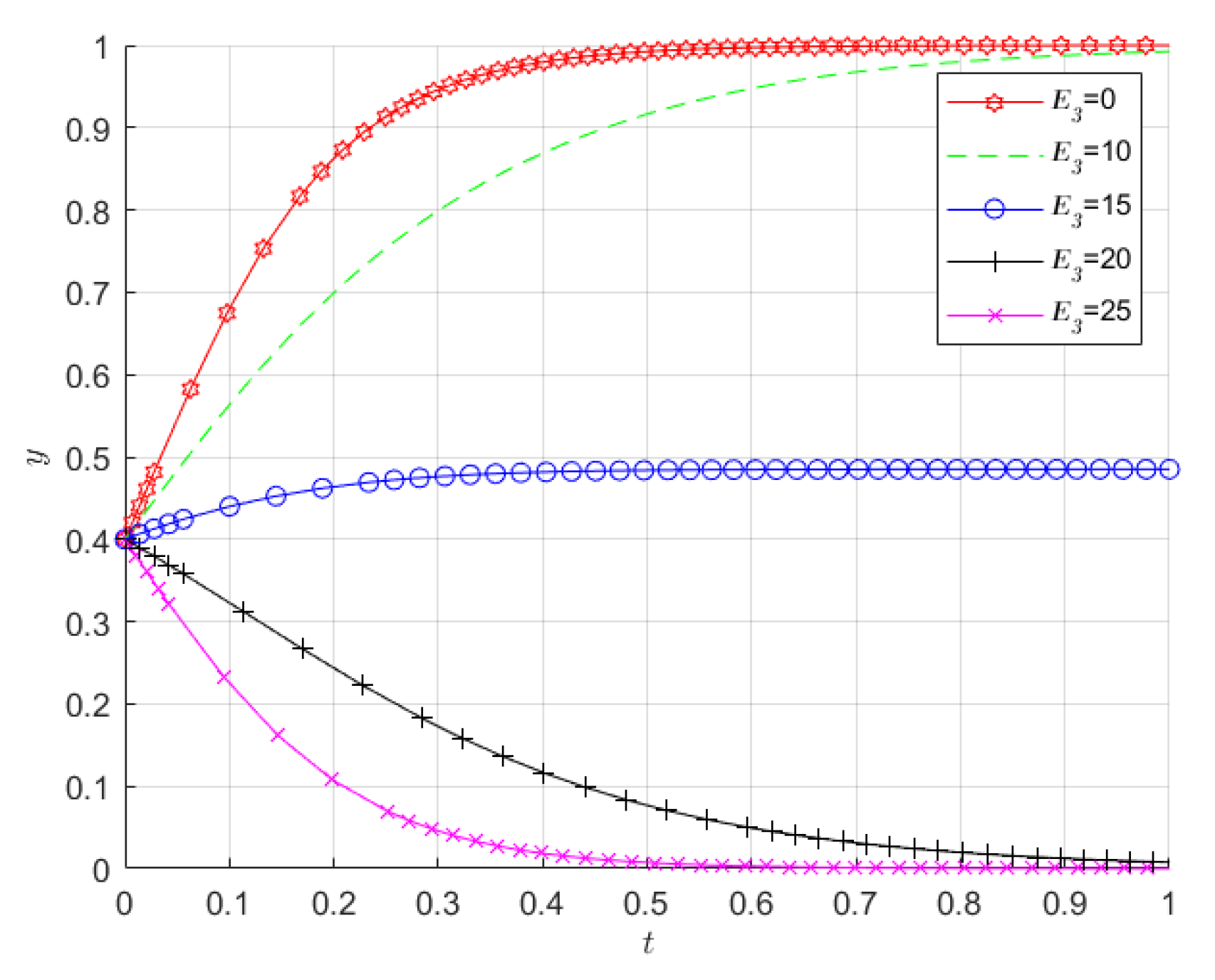
| Agents | Parameters | Descriptions |
|---|---|---|
| Government | G1 | Government’s initial benefits. |
| G2 | The human, material, and financial costs incurred by the government in adopting Positive regulation strategies. | |
| G3 | The fines imposed by the government on construction units that pollute the environment during regulation and regulate. | |
| G4 | The government’s industrial upgrading benefits that the equipment manufacturers carry out positive innovation of electric equipment. | |
| G5 | The government’s ecological benefits that the construction units carry out positive application of electric equipment. | |
| Equipment manufacturers | E1 | Equipment manufacturers’ initial benefits. |
| E2 | The equipment manufacturers’ brand benefits from carrying out positive innovation of electric equipment to increase. | |
| E3 | The additional R&D costs incurred by the equipment manufacturers in adopting positive innovation for electric equipment. | |
| E4 | The additional incentives provided by the government to the equipment manufacturers that carry out positive innovation of electric equipment. | |
| Construction units | C1 | Construction units’ initial benefits. |
| C2 | The additional costs incurred by maintenance and purchase of spare equipment due to immature technology when applying electric equipment for the construction units before the equipment manufacturer carries out positive innovation. | |
| C3 | The reduced costs that the construction unit applies the electric equipment after the equipment manufacturer carries out positive innovation. | |
| C4 | The government subsidies for the construction units by carrying out positive application of electric equipment. |
| Equipment Manufacturers | |||||
|---|---|---|---|---|---|
| Positive Innovation (y) | Negative Innovation (1 − y) | ||||
| Construction Units | |||||
| Positive Application (z) | Negative Application (1 − z) | Positive Application (z) | Negative Application (1 − z) | ||
| Government | Positive regulation (x) | (Positive regulation, Positive innovation, Positive application) | (Positive regulation, Positive innovation, Negative application) | (Positive regulation, Negative innovation, Positive application) | (Positive regulation, Negative innovation, Negative application) |
| Negative regulation (1 − x) | (Negative regulation, Positive innovation, Positive application) | (Negative regulation, Positive innovation, Negative application) | (Negative regulation, Negative innovation, Positive application) | (Negative regulation, Negative innovation, Negative application) | |
| Behavioral Strategies | Government’s Benefits | Equipment Manufacturers’ Benefits | Construction Units’ Benefits |
|---|---|---|---|
| (Positive regulation, Positive innovation, Positive application) | G1 − G2 + G4 + G5 − E4 − C4 | E1 + E2 − E3 + E4 | C1 + C3 + C4 |
| (Positive regulation, Positive innovation, Negative application) | G1 − G2 + G3 + G4 − E4 | E1 + E2 − E3 + E4 | C1 − G3 |
| (Positive regulation, Negative innovation, Positive application) | G1 − G2 + G5 − C4 | E1 | C1 − C2 + C4 |
| (Positive regulation, Negative innovation, Negative application) | G1 − G2 + G3 | E1 | C1 − G3 |
| (Negative regulation, Positive innovation, Positive application) | G1 + G4 + G5 | E1 + E2 − E3 | C1 + C3 |
| (Negative regulation, Positive innovation, Negative application) | G1 + G4 | E1 + E2 − E3 | C1 |
| (Negative regulation, Negative innovation, Positive application) | G1 + G5 | E1 | C1 − C2 |
| (Negative regulation, Negative innovation, Negative application) | G1 | E1 | C1 |
| Equilibrium Point | λ1 | λ2 | λ3 | Stability Condition |
|---|---|---|---|---|
| P1 (0,0,0) | E2 − E3 | G3 − G2 | −C2 | E2 − E3 < 0, G3 − G2 < 0 |
| P2 (0,0,1) | C2 | E2 − E3 | −G2 − C4 | unstable point |
| P3 (0,1,0) | C3 | E3 − E2 | G3 − G2 − E4 | unstable point |
| P4 (0,1,1) | E3 − E2 | −C3 | −C4 − E4 − G2 | E3 − E2 < 0 |
| P5 (1,0,0) | G2 − G3 | C4 − C2 + G3 | E2 − E3 + E4 | unstable point |
| P6 (1,0,1) | C4 + G2 | E2 − E3 + E4 | C2 − C4 − G3 | unstable point |
| P7 (1,1,0) | C3 + C4 + G3 | E4+G2 − G3 | E3 − E2 − E4 | unstable point |
| P8 (1,1,1) | G2 + C4 + E4 | −C3 − C4 − G3 | E3 − E2 − E4 | unstable point |
| Agents | Government | Equipment Manufacturers | Construction Units | ||||||||||
|---|---|---|---|---|---|---|---|---|---|---|---|---|---|
| Parameter | G1 | G2 | G3 | G4 | G5 | E1 | E2 | E3 | E4 | C1 | C2 | C3 | C4 |
| Assignment | 100 | 5 | 5 | 10 | 10 | 100 | 15 | 10 | 5 | 100 | 10 | 15 | 5 |
Publisher’s Note: MDPI stays neutral with regard to jurisdictional claims in published maps and institutional affiliations. |
© 2022 by the authors. Licensee MDPI, Basel, Switzerland. This article is an open access article distributed under the terms and conditions of the Creative Commons Attribution (CC BY) license (https://creativecommons.org/licenses/by/4.0/).
Share and Cite
Yang, X.; Liu, Y.; Liu, K.; Hu, G.; Zhao, X. Research on Promotion and Application Strategy of Electric Equipment in Plateau Railway Tunnel Based on Evolutionary Game. Sustainability 2022, 14, 15309. https://doi.org/10.3390/su142215309
Yang X, Liu Y, Liu K, Hu G, Zhao X. Research on Promotion and Application Strategy of Electric Equipment in Plateau Railway Tunnel Based on Evolutionary Game. Sustainability. 2022; 14(22):15309. https://doi.org/10.3390/su142215309
Chicago/Turabian StyleYang, Xiaoxu, Yuming Liu, Kai Liu, Guangzhong Hu, and Xi Zhao. 2022. "Research on Promotion and Application Strategy of Electric Equipment in Plateau Railway Tunnel Based on Evolutionary Game" Sustainability 14, no. 22: 15309. https://doi.org/10.3390/su142215309
APA StyleYang, X., Liu, Y., Liu, K., Hu, G., & Zhao, X. (2022). Research on Promotion and Application Strategy of Electric Equipment in Plateau Railway Tunnel Based on Evolutionary Game. Sustainability, 14(22), 15309. https://doi.org/10.3390/su142215309







